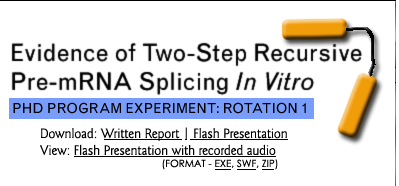|
 |
METHODS: Materials and Methods are explained in detail in the written report link listed above. This online report will feature a short explanation of the techniques. Cloning and Transformation: Cloning is the process of taking a DNA sequences from one species and moving it into another species. This is usually done by moving the sequences onto a plasmid, which is a dna strand that the ends attach to itself to form a circle. Plasmids on occasion can be transferred to different species and be functional. The process of moving a plasmid into another species is called transformation. In this experiment the DNA to form the two step recursive splice construct was cloned from a human gene and moved to a plasmid. It was then transformed into E. coli bacteria for further modifications. Site Directed Mutagenesis: Site Directed Mutagenesis allows scientist to modify the DNA sequence to test hypothesis of the result of the change. In this experiment, Site directed mutagenesis was used to modify the special sequence believed to cause the multi-step splicing effect. The goal is to mutate this site to see if it will dictate whether splicing occurs at this site or not. Production of pre-MRNA substrate and in vitro splicing: The goal of an in vitro experiment is to recreate, as closely as possible, the enviroment that exist within living cells, in a test tube. In this experiment, it was the goal to create mRNA from DNA in a test tube and to then take that mRNA and see if it could be spliced. To do this, it was important to add all the components a cell uses to complete these processes into the test tube. In the case of in vitro splicing, cell extracts from HeLa cells were placed into the test tubes, thus providing the machinery to carry out mRNA splicing. Poly Acrylamide Gel (PAGE) Analysis: Page analysis is the process of placing samples onto a gel and running an electric current through. The electric current then moves the samples according to the size of the samples. The smaller the fragment, the further it will move down the gel (aka "runs quicker"). The fragments tend to run in bands. The result is the ability to determine the size of various fragments. In the experiment, the size of the mRNA is known as well as the location of the special splice site. This allows for an expectation of the sizes of fragments that would be expected if the experiment follows the model. Autoradiography: In the process of creating the mRNA in vitro, the normal bases were substituted with radioactive bases (Phosphorus-32 labelled UTP). Once the mRNA is labelled in this manner it is possible to use a special film that detects this radiation. This process combined with PAGE analysis creates a result where the location of the bands appear on a piece of film that allows for the analysis of the fragment sizes. |
